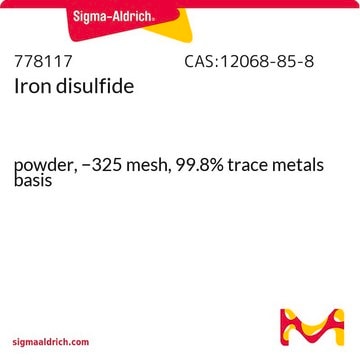343161
Iron(II) sulfide
−100 mesh, 99.9% trace metals basis
Synonym(s):
Ferrous sulfide
Sign Into View Organizational & Contract Pricing
All Photos(2)
About This Item
Empirical Formula (Hill Notation):
FeS
CAS Number:
Molecular Weight:
87.91
EC Number:
MDL number:
UNSPSC Code:
12352302
eCl@ss:
38190405
PubChem Substance ID:
NACRES:
NA.55
Recommended Products
Assay
99.9% trace metals basis
form
powder
reaction suitability
reagent type: catalyst
core: iron
particle size
−100 mesh
density
4.84 g/mL at 25 °C (lit.)
SMILES string
S=[Fe]
InChI
1S/Fe.S
InChI key
MBMLMWLHJBBADN-UHFFFAOYSA-N
Looking for similar products? Visit Product Comparison Guide
Related Categories
Application
- Progress in bioleaching: fundamentals and mechanisms of microbial metal sulfide oxidation - part A: This study delves into the microbial oxidation of metal sulfides like Iron(II) sulfide, shedding light on bioleaching processes crucial for the extraction of valuable metals from ores, which is highly relevant for environmental and materials science applications (Vera et al., 2022).
- Novel QTL Associated with Aerenchyma-Mediated Radial Oxygen Loss (ROL) in Rice: Explores genetic traits influenced by conditions such as the presence of Iron(II) sulfide in paddy fields, providing insights into how rice adapts to iron-rich anaerobic soils, which is vital for agricultural biotechnology and crop science (Duyen et al., 2022).
- Fe(ii) and Fe(iii) dithiocarbamate complexes as single source precursors: Investigates the synthesis of nanoscale iron sulfides from these precursors, using in situ X-ray absorption spectroscopy, which is essential for developing advanced materials with specific magnetic and electronic properties (Roffey et al., 2019).
Storage Class Code
11 - Combustible Solids
WGK
WGK 3
Flash Point(F)
Not applicable
Flash Point(C)
Not applicable
Certificates of Analysis (COA)
Search for Certificates of Analysis (COA) by entering the products Lot/Batch Number. Lot and Batch Numbers can be found on a product’s label following the words ‘Lot’ or ‘Batch’.
Already Own This Product?
Find documentation for the products that you have recently purchased in the Document Library.
Customers Also Viewed
N Finck et al.
Environmental science & technology, 46(18), 10004-10011 (2012-08-21)
The isotope (79)Se may be of great concern with regard to the safe disposal of nuclear wastes in deep geological repositories due to its long half-life and potential mobility in the geosphere. The Se mobility is controlled by the oxidation
Amit Kumar Dutta et al.
ACS applied materials & interfaces, 4(4), 1919-1927 (2012-03-28)
Nanocrystalline FeS and FeSe compounds were prepared by solvothermal decomposition of a precursor complex [Fe(3)(μ(3)-O)(μ(2)-O(2)CCH(2)Cl)(6)(H(2)O)(3)]NO(3)·H(2)O in the presence of thiourea and sodium selenite, respectively. The as-obtained products were characterized by X-ray diffraction analysis (XRD), field emission scanning electron microscopy (FESEM)
Andrew D Henderson et al.
Water research, 47(3), 1267-1276 (2012-12-19)
Iron sulfide (FeS) has been extensively assessed as a reactive medium to remove both metals and halogenated organics from groundwater. However, to address its suitability as a material for permeable reactive barriers (PRBs), its propensity for solids and gas production
The structural plasticity of the proximal [4Fe3S] cluster is responsible for the O2 tolerance of membrane-bound [NiFe] hydrogenases.
Jean-Marie Mouesca et al.
Angewandte Chemie (International ed. in English), 52(7), 2002-2006 (2013-01-09)
Chen Xu et al.
ACS nano, 6(6), 4713-4721 (2012-05-10)
We report a facile approach to prepare carbon-coated troilite FeS (C@FeS) nanosheets via surfactant-assisted solution-based synthesis. 1-Dodecanethiol is used as both the sulfur source and the surfactant, which may form different-shaped micelles to direct the growth of nanostructures. Under appropriate
Our team of scientists has experience in all areas of research including Life Science, Material Science, Chemical Synthesis, Chromatography, Analytical and many others.
Contact Technical Service









